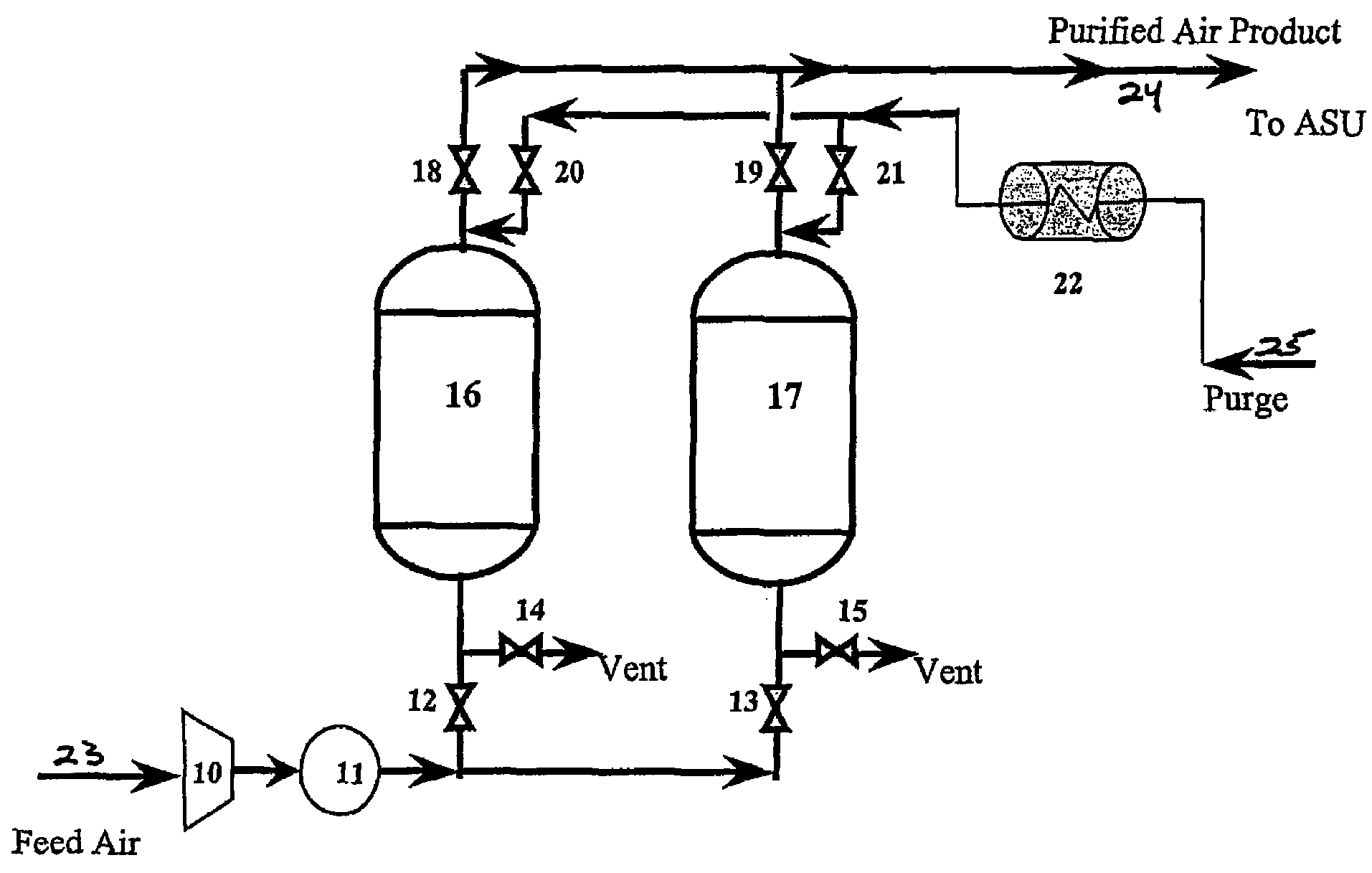Method and apparatus for gas purification
a technology of gas purification and gas filter, which is applied in the direction of separation process, colloidal chemistry, dispersed particle separation, etc., can solve the problems of greater than 50 ppb of nsub>2/sub>o, potential hazard of acetylene and other hydrocarbons in air, explosion hazards, etc., and achieve the effect of superior n2o removal efficiency
- Summary
- Abstract
- Description
- Claims
- Application Information
AI Technical Summary
Benefits of technology
Problems solved by technology
Method used
Image
Examples
example 1
N2 Coadsorption Effects
[0067]Adsorbents were tested as described above to determine the effect of N2 coadsorption upon the adsorption of N2O. The results of the saturation capacity of N2O (1.0 ppm) in N2 and in He on various adsorbents are compared in Table 1 below. These results were determined for feed conditions of 6.0 bar, 300° K. and 0.08 kmol / m2 s molar flux using a 22.9 cm or 5.6 cm adsorbent bed length. The SiO2 / Al2O3 ratio is specified for some adsorbents in the table, e.g. NaX (SiO2 / Al2O3=2.3). FIG. 2 shows N2O breakthrough curves for adsorbent 13X (NaX 2.5) for N2O in N2 and N2O in He.
[0068]
TABLE 1Effect of N2 Coadsorption Upon N2O LoadingN2O loadingN2O loading(mmol / gm)(mmol / gm)1.0 ppm1.0 ppmPreferredMaterialN2O / HeN2O / N2AdsorbentsNaY4.06 × 10−41.42 × 10−4NaZSM5 1.7 × 10−33.59 × 10−4NaKX4.58 × 10−413X NaX (2.5)9.55 × 10−46.09 × 10−4NaX (2.3)1.73 × 10−37.03 × 10−4CaX1.98 × 10−3Na-Mordenite6.38 × 10−3Clinoptilolite (CS400)8.86 × 10−23.60 × 10−3XLiX (2.3) 5.5 × 10−31.22 × 10−...
example 2
N2 Isotherms
[0070]Isotherms for N2 at 300° K were determined for various adsorbents over a range of pressures which included typical feed pressures to a prepurifier of a cryogenic air separation unit. Example isotherms are shown in FIG. 3. The pure component N2 loadings from these isotherms are compared in Table 2 for various adsorbents at 6.0 bar.
[0071]
TABLE 2Equilibrium Loadings of N2 at 6.0 bar, 300° KMaterialN2 loading (mmol / gm)Silicalite0.68H-ZSM50.744A1.11NaY0.85NaZSM5NaKX0.8613X NaX (2.5)1.30NaX (2.3)1.33CaX1.53Na-Mordenite1.40Clinoptilolite (CS400)0.64LiX (2.3)1.71LiX (2.0)2.29Chabazite1.22Clinoptilolite (TSM140)1.23
example 3
Breakthrough at 50 ppb N2O
[0072]The average N2O loading (IBL) of the adsorbent bed was determined at 50.0 ppb N2O from the same N2O / N2 tests reported in Table 1 above. Typical breakthrough results are illustrated in FIG. 4. The IBL values (reflecting not only the 50 ppb breakthrough, but also N2 coadsorption) are compared for various adsorbents in Table 3 and shown in FIG. 5. Separation factors were also computed using Equation 3. The N2 loadings at 6 bar from Table 2 are used in Equation 3 to represent the working capacity of N2 in the process.
[0073]N2O working capacities can be computed either from the saturation loadings of N2O / N2 or from the average loadings of N2O at the IBL. The separation factor computed from the average loadings at the IBL is the preferred method since it reflects both the equilibrium and dynamic effects of the adsorbent. Nevertheless, the former method (which reflects equilibrium effects only) is acceptable when only isotherms and no breakthrough data are a...
PUM
| Property | Measurement | Unit |
|---|---|---|
| pressure | aaaaa | aaaaa |
| pressure | aaaaa | aaaaa |
| temperature | aaaaa | aaaaa |
Abstract
Description
Claims
Application Information
 Login to View More
Login to View More - R&D
- Intellectual Property
- Life Sciences
- Materials
- Tech Scout
- Unparalleled Data Quality
- Higher Quality Content
- 60% Fewer Hallucinations
Browse by: Latest US Patents, China's latest patents, Technical Efficacy Thesaurus, Application Domain, Technology Topic, Popular Technical Reports.
© 2025 PatSnap. All rights reserved.Legal|Privacy policy|Modern Slavery Act Transparency Statement|Sitemap|About US| Contact US: help@patsnap.com



